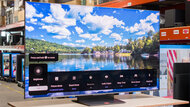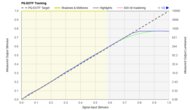If you're looking for a new TV for your home theater setup, there are a few things that you should pay attention to to get the best movie-watching experience possible. Contrast ratio is the ratio between the luminance of the brightest white and darkest black that a TV can produce. High contrast means that a TV can display deep blacks, which helps to improve the perceived depth of an image. Furthermore, TVs with great contrast ratios are better at emphasizing bright highlights in HDR, which is why OLEDs, which have a near-infinite contrast ratio due to their perfect blacks, typically offer the best overall HDR movie-watching experience.
With the rise of HDR movies, HDR brightness plays a big role in how impactful those movies are. This is where high-end TVs have the biggest advantage, as HDR content uses their higher brightness capabilities to show lifelike highlights. Since the content dictates the brightness of HDR movies, you'll want a TV that can come close to or fully display highlights at the brightness level a filmmaker intends. A TV with limited HDR peak brightness can't properly display highlights, so the overall image will lack impact. A TV's color gamut is another big factor for watching movies in HDR. Through our testing, we can see if a TV displays the wide range of colors needed for a vibrant HDR movie-watching experience.
What if you don't strictly watch high-quality HDR movies through streaming or on disc? That's where image processing comes in. Upscaling capabilities are pretty self-explanatory, and we test whether or not a TV does a good job upscaling low-resolution content. If it doesn't, you will end up with an image that looks soft and lacks detail. Low-quality content smoothing is the term we use to describe how a TV removes artifacts from low-bitrate content. If a TV performs well here, you won't see many artifacts like macro-blocking during dark scenes.
Below are our recommendations for the best TVs for movies you can buy. See our picks for the best OLED TVs, the best bright room TVs, and the best 4k TVs, or vote on which ones you want us to buy and test. You could also consider one of the best home projectors or best home theater projectors instead of a TV. To learn more about the current TV models on the market, check out our 2025 TV lineup page.
Quick Look






We buy and test dozens of TVs yearly, taking an objective, data-driven approach to deliver results you can trust. Our testing process is complex, with hundreds of individual tests that take over a week to complete. Most of our tests are done with specially designed test patterns that mimic real content, but we also use the same sources you have at home to ensure our results match the real-world experience. We use two main tools for our testing: a Colorimetry Research CR-100 colorimeter and a CR-250 spectroradiometer.
-
Best TV For Watching Movies
 Home Theater9.0Mixed Usage8.9Gaming9.3Bright Room8.8Sports8.8Brightness8.7Black Level10Color9.1Processing (In Development)8.3Game Mode Responsiveness9.4Resolution4kNative Refresh Rate165HzScreen FinishMatteTypeOLEDSub-TypeQD-OLEDSee all our test resultsDolby VisionNo
Home Theater9.0Mixed Usage8.9Gaming9.3Bright Room8.8Sports8.8Brightness8.7Black Level10Color9.1Processing (In Development)8.3Game Mode Responsiveness9.4Resolution4kNative Refresh Rate165HzScreen FinishMatteTypeOLEDSub-TypeQD-OLEDSee all our test resultsDolby VisionNoThe overall best TV for movies we've tested is the Samsung S95F OLED. Its combination of perfect black levels, amazing HDR brightness, and incredibly vibrant colors gives it stunning image quality. Due to the TV's perfect black levels, blacks are inky with no haloing around highlights and subtitles. Colors are vivid and lifelike due to the TV's QD-OLED panel, so it has no problem displaying the punchiest colors in animated movies. Furthermore, highlights in HDR movies really pop out, so this model really takes advantage of the capabilities of HDR. If you have a wide seating area, this TV's nearly perfect viewing angle means image quality doesn't degrade when watching the TV from an angle, which is great when you have friends over to watch the newest hit movie.
If you're a bit more traditional and still watch older films on DVD and regular Blu-ray, the TV does a great job upscaling, so you still get a sharp image with visible details. It doesn't do as good a job reducing artifacts in heavily compressed streams, so you still see some noise when you're stuck watching low-bitrate movies, but it doesn't overly smooth out details, which is nice. If you care about the content creator's intent, this model is accurate out-of-the-box in SDR and HDR, so you don't need to pay a premium to get it calibrated. It comes equipped with Samsung's Tizen OS, so you can easily find all the mainstream streaming apps. Unfortunately, it doesn't support Dolby Vision, but it does offer the similar HDR10+. It also doesn't support DTS audio passthrough, which is a downside for physical media collectors who need their TV to send audio to their soundbar.
-
Best LED TV For Watching Movies
 Home Theater8.6Mixed Usage8.4Gaming7.7Bright Room8.5Sports8.5Brightness9.0Black Level8.7Color8.5Processing (In Development)8.7Game Mode Responsiveness6.5Resolution4kNative Refresh Rate120HzScreen FinishGlossyTypeLEDSub-TypeVASee all our test resultsDolby VisionYes
Home Theater8.6Mixed Usage8.4Gaming7.7Bright Room8.5Sports8.5Brightness9.0Black Level8.7Color8.5Processing (In Development)8.7Game Mode Responsiveness6.5Resolution4kNative Refresh Rate120HzScreen FinishGlossyTypeLEDSub-TypeVASee all our test resultsDolby VisionYesWhat if you don't want an OLED, but still want top-tier image quality? If that's the case, consider the Sony BRAVIA 9. It doesn't display the same perfect blacks as an OLED, but blacks still look very deep and bold, and there's essentially no haloing around highlights and subtitles, so you don't have to worry about bright areas bleeding into dark ones. Colors aren't quite as vivid as they are on a QD-OLED like the Samsung S95F OLED, but they're still punchy and incredibly accurate without needing calibration, which is great for those who care about the filmmaker's intent. The TV is even brighter than the S95F, so highlights in HDR movies really pop out. Furthermore, that brightness means it easily overcomes glare from indirect light sources. However, it doesn't do the best job handling mirror-like reflections; if you have a lamp or window directly facing the screen, it's visible.
Unlike any OLED on our list, this TV has a relatively narrow viewing angle, so image quality degrades when you're watching from an angle. It's not too bad for an LED model, but it's still not suitable for wide seating arrangements. One of its standout features is Sony's legendary processing, which makes low-quality and low-resolution content look about as good as they can, and is great to have for people who still collect DVDs or are stuck watching heavily compressed streams. If you're watching high-quality sources like a 4k Blu-ray or streams on Sony Pictures Core, you get Dolby Vision and DTS audio passthrough, so your bases are covered. It runs the popular Google TV OS, which is absolutely loaded with a ton of apps, so finding content to watch is a breeze.
-
Best Upper Mid-Range TV For Watching Movies
 Home Theater8.8Mixed Usage8.6Gaming8.8Bright Room7.7Sports8.2Brightness8.3Black Level10Color8.3Processing (In Development)8.7Game Mode Responsiveness9.3Resolution4kNative Refresh Rate144HzScreen FinishGlossyTypeOLEDSub-TypeWOLEDSee all our test resultsDolby VisionYes
Home Theater8.8Mixed Usage8.6Gaming8.8Bright Room7.7Sports8.2Brightness8.3Black Level10Color8.3Processing (In Development)8.7Game Mode Responsiveness9.3Resolution4kNative Refresh Rate144HzScreen FinishGlossyTypeOLEDSub-TypeWOLEDSee all our test resultsDolby VisionYesIf you like the image processing and support for Dolby Vision that the Sony BRAVIA 9 provides, but you really want an OLED, go with the LG C5 OLED. Its image processing is almost on par with the Sony, so it's great for watching DVDs or other low-resolution and low-quality sources. It's also almost as accurate as the Sony out of the box, so it stays true to the filmmaker's intent. It displays perfect blacks, has the brightness needed to make highlights pop in HDR, and displays vibrant colors, so HDR content looks great in a dark room. The TV has a wide viewing angle, making it suitable for wide seating arrangements. Furthermore, it has the brightness and reflection handling needed to overcome glare from indirect lighting, so it's suitable for most bright rooms. Like the Sony, it struggles with direct reflections, so avoid placing the screen directly in front of any light sources, and you're good to go.
It supports the popular Dolby Vision format, which is great, since many streaming services and 4k Blu-rays utilize that HDR format. Sadly, it doesn't passthrough DTS audio formats, so you need to have a receiver or soundbar with HDMI IN if you want to listen to audio tracks in DTS. It runs LG's webOS as its smart platform, so even though you don't get the massive catalogue of apps Google TV offers, it still offers a large catalogue with all the popular streaming services.
-
Best Mid-Range TV For Watching Movies
 Home Theater8.6Mixed Usage8.4Gaming8.4Bright Room8.4Sports8.3Brightness9.1Black Level9.2Color8.0Processing (In Development)7.8Game Mode Responsiveness8.0Resolution4kNative Refresh Rate144HzScreen FinishGlossyTypeLEDSub-TypeVASee all our test resultsDolby VisionYes
Home Theater8.6Mixed Usage8.4Gaming8.4Bright Room8.4Sports8.3Brightness9.1Black Level9.2Color8.0Processing (In Development)7.8Game Mode Responsiveness8.0Resolution4kNative Refresh Rate144HzScreen FinishGlossyTypeLEDSub-TypeVASee all our test resultsDolby VisionYesThe TCL QM8K is a great TV all-around that offers a wide variety of features and very good image quality. It doesn't display the same perfect blacks as an OLED, but blacks are still deep and bold in a dark room. There's a tiny bit more haloing on this LED model than there is on the Sony BRAVIA 9, but it's barely noticeable during most scenes. Colors are vibrant and punchy, but they're not nearly as accurate out-of-the-box as they are on the other picks on this list so far, so you need to get it calibrated if you want the most accurate image possible. This is a very bright TV, so it has no problem displaying very bright highlights in HDR movies. Like most other TVs on our list, it easily overcomes glare from indirect lighting, but direct lights are visible on the screen.
The TV has a pretty narrow viewing angle, so it's best to sit centered to the screen if you want the best image quality. Fortunately, this TV is loaded with features like support for Dolby Vision, HDR10+, and DTS audio passthrough, so compatibility isn't an issue at all. It does a great job cleaning up artifacts in low-bitrate content. The TV also does a good job upscaling, so the image doesn't look too soft when you're watching movies in a low resolution. It utilizes the Google TV OS, so finding apps and new movies to watch is very easy. It even comes in a massive 98-inch model, which will certainly stand out in your home theater.
-
Best Lower Mid-Range TV For Watching Movies
 Home Theater7.9Mixed Usage7.8Gaming7.8Bright Room8.0Sports7.9Brightness7.8Black Level8.4Color7.5Processing (In Development)7.7Game Mode Responsiveness8.0Resolution4kNative Refresh Rate144HzScreen FinishGlossyTypeLEDSub-TypeVASee all our test resultsDolby VisionYes
Home Theater7.9Mixed Usage7.8Gaming7.8Bright Room8.0Sports7.9Brightness7.8Black Level8.4Color7.5Processing (In Development)7.7Game Mode Responsiveness8.0Resolution4kNative Refresh Rate144HzScreen FinishGlossyTypeLEDSub-TypeVASee all our test resultsDolby VisionYesIf the TCL QM8K is a bit out of your price range, but you like what it offers, you can step down to the TCL QM7K. Blacks are pretty much just as deep as they are on the more expensive model, but there's more visible haloing. This means that the area around highlights in otherwise dark scenes glow into the dark area, which affects the appearance of blacks. In most scenes, you won't notice it, but it's more noticeable if you use subtitles. Colors aren't quite as punchy as they are on the QM8K, but they still look vibrant and lifelike, and the TV has the HDR brightness needed to make highlights stand out. Like the QM8K, you will want to get this TV calibrated if you want the most accurate colors. Its viewing angle is just as narrow as the higher-end model, so image quality is degraded when viewed at an angle.
The TV's bright room performance is similar; it overcomes glare from indirect lights, but direct light sources are distracting. It supports Dolby Vision, HDR10+, and DTS audio passthrough, so it has excellent compatibility. Like many TVs, it runs Google TV, so you have every streaming app at your disposal. It's not quite as good at upscaling as the QM8K, but it's still decent enough that the image doesn't look soft and void of details. It does a very similar job cleaning up artifacts in heavily compressed movies, which is great. This is a very solid TV overall, and even most cinephiles will be impressed with the image quality it provides when watching their favorite films.
-
Best Budget TV For Watching Movies
 Home Theater7.2Mixed Usage7.1Gaming7.2Bright Room7.0Sports7.1Brightness6.5Black Level7.6Color7.2Processing (In Development)7.0Game Mode Responsiveness7.9Resolution4kNative Refresh Rate144HzScreen FinishGlossyTypeLEDSub-TypeVASee all our test resultsDolby VisionYes
Home Theater7.2Mixed Usage7.1Gaming7.2Bright Room7.0Sports7.1Brightness6.5Black Level7.6Color7.2Processing (In Development)7.0Game Mode Responsiveness7.9Resolution4kNative Refresh Rate144HzScreen FinishGlossyTypeLEDSub-TypeVASee all our test resultsDolby VisionYesIf you're looking for something more budget-oriented but still want a good movie-watching experience, the TCL QM6K offers that. Unlike many budget models on the market, it has local dimming to deepen blacks. They're not nearly as bold as they are on the other TVs on our list, but they're still deep enough to give the image solid depth, especially in a dark room. However, there's more noticeable haloing around highlights in dark scenes, and subtitles have a visible glow around them. Colors aren't as vibrant as they are on the TCL QM7K when watching colorful animated films, but the TV is vibrant enough that the image doesn't look dull. Surprisingly, colors are more accurate on this model than they are on the higher-end TCLs out of the box, which is great. Highlights in HDR films don't stand out as much as they should, but you still get a fairly impactful HDR experience.
The TV is bright enough to fight glare when you have your overhead lights on, but direct light sources are very distracting. The TV also has a narrow viewing angle, so it's not very good for wide seating arrangements. Its processing is okay, but there are visible artifacts in low-bitrate content, and low-resolution content lacks some detail. Fortunately, it has great compatibility when you're watching high-quality sources, since the TV supports Dolby Vision, HDR10+, and DTS audio passthrough. Like the other TCL models, it runs Google TV, so you certainly won't have a hard time finding something to watch.
Notable Mentions
-
Sony A95L OLED:
The Sony A95L OLED competes with the Samsung S95F OLED and is a very strong contender for our top spot. The Sony offers slightly better processing, and it supports both Dolby Vision and DTS audio passthrough. However, the Samsung offers brighter highlights and colors in HDR, a superior bright room experience, comes with the versatile One Connect box, and supports HDR10+. Both TVs are amazing, so go with the one that's more suitable for your needs.
See our review -
Sony BRAVIA 7:
The Sony BRAVIA 7 is a good choice for those who want a Sony TV but can't afford the pricey Sony BRAVIA 9. It has a narrower viewing angle, blacks aren't as deep, and it has noticeably worse reflection handling. However, you get similar brightness and almost identical image processing, so it's a good choice if you want a Sony model to watch movies on.
See our review -
Samsung S90F OLED:
The Samsung S90F competes with the LG C5 OLED. The Samsung has the advantage when it comes to colors, but the LG offers Dolby Vision, superior processing, and deeper blacks in a bright room, making it the more complete package for movie fans.
See our review -
LG B5 OLED:
The LG B5 OLED is a midrange TV that competes with a model like the TCL QM8K. The LG offers superior black levels and a wider viewing angle, but the TCL offers better brightness, better HDR colors, and overall image processing. It also supports DTS audio and HDR10+, making it the better all-around option.
See our review -
Hisense U75QG:
The Hisense U75QG is similar to the TCL QM7K, but it offers better peak brightness. Unfortunately, the Hisense makes HDR content look much brighter than intended. Since the TCL stays truer to the filmmaker's intent and has superior contrast, it looks better when watching movies.
See our review -
Hisense U65QF:
The Hisense U65QF competes with the TCL QM6K but offers more brightness. However, the Hisense really overbrightens HDR content, so it doesn't stay true to the filmmaker's intent. The TCL offers a more well-rounded movie-watching experience, with better black levels and superior accuracy.
See our review
Recent Updates
Nov 19, 2025:
We confirmed the accuracy of our current picks and ensured all products are in stock.
Aug 28, 2025:
Replaced the Sony A95L OLED with the Samsung S95F OLED, the LG C4 OLED with the LG C5 OLED, the LG B4 OLED with the TCL QM8K, the Hisense U7N with the TCL QM7K, and the Hisense U6N with the TCL QM6K. We also renamed the 'Best Bright Room' category to 'Best LED' since it's more fitting to the article. Finally, we updated the Notable Mentions section.
Feb 27, 2025:
Added a link to our 2025 TV lineup article and confirmed the accuracy of our current picks.
Dec 06, 2024:
Updated the introduction to make it clearer and more concise.
Sep 12, 2024: Replaced the Sony A75L OLED with the LG B4 OLED in the 'Best Mid-Range TV For Watching Movies' category. We also replaced the Hisense U6/U6K, Hisense U7K, and LG C3 OLED with their 2024 successors and refreshed the Notable Mentions section.
All Reviews
Our recommendations above are what we think are currently the best TVs for movies for most people in each price range. We factor in the price (a cheaper TV wins over a pricier one if the difference isn't worth it), feedback from our visitors, and availability (no TVs that are difficult to find or almost out of stock everywhere).
If you would like to do the work of choosing yourself, here is the list of all our TV reviews. Be careful not to get too caught up in the details. While no TV is perfect, most TVs are great enough to please almost everyone, and the differences are often not noticeable unless you really look for them. Also, keep in mind that our scores aren't comparable across different test benches, so the older TVs in the list below score higher than they would today.



















